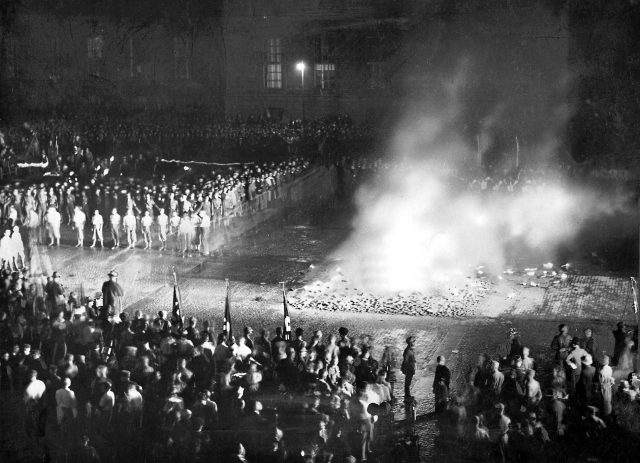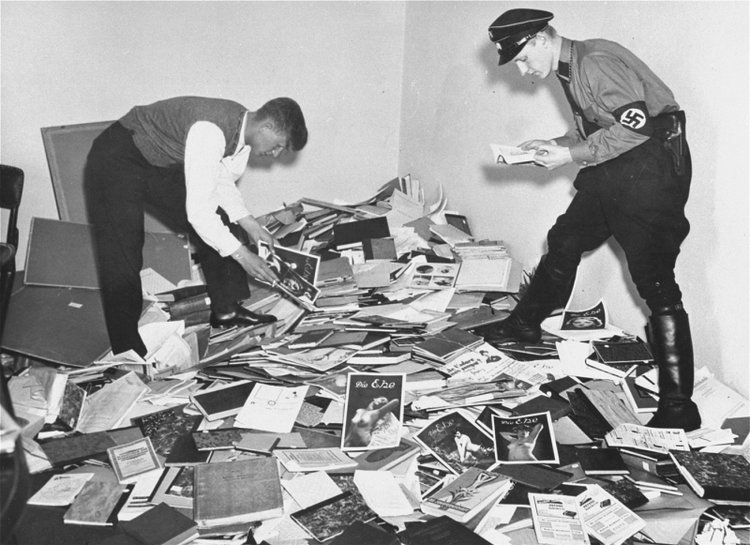
History offers us many examples on exactly how far totalitarian censorship can go. However, none is more audacious than the events that happened in the Nazi Germany. If the communist bloc used a string of bureaucratic measures to slowly choke out literature and press they found “dangerous”, Hitler’s adepts and acolytes chose to employ censorship through an ample spectacle. This is the uncensored story of the 1933 book burnings.
Prelude
What is often referred to as the “Bücherverbrennung” in German, began with a carefully orchestrated campaign by the Nazi Party to purge German society of literature deemed “un-German” or contrary to Nazi ideology. The events leading up to the book burnings were fueled by the rise of Adolf Hitler and the National Socialist German Workers’ Party (NSDAP) to power in Germany.
The Nazi Party, upon assuming control of the German government in January 1933, wasted no time in implementing its agenda of censorship and cultural purification. One of the first steps taken by the regime was the establishment of the Reich Ministry of Public Enlightenment and Propaganda, headed by Joseph Goebbels. This ministry played a central role in shaping public opinion and disseminating Nazi propaganda, including the demonization of certain books and authors.
In February 1933, the Reichstag Fire occurred, an event that the Nazis exploited to crack down on political dissent and further consolidate their power. The fire was blamed on communists, and in its aftermath, the Nazis used the pretext of protecting national security to suppress opposition parties, trade unions, and independent media outlets.
In March 1933, just two months after Hitler became Chancellor, the Nazi Party organized a nationwide boycott of Jewish-owned businesses, professionals, and intellectuals. This boycott, coupled with the removal of Jewish individuals from positions of influence and authority, set the stage for the escalating persecution of Jews in Germany.
Bücherverbrennung
The actual book burnings took place on the night of May 10, 1933, in cities across Germany. The burnings were preceded by inflammatory speeches and propaganda campaigns designed to whip up public sentiment against the targeted books and authors. Nazi student organizations, under the direction of the German Student Union (Deutsche Studentenschaft), played a leading role in organizing and executing the burnings.
In Berlin, the book burning took place at the Opernplatz (now Bebelplatz), near the University of Berlin. Thousands of books were piled high on a makeshift pyre, while Nazi officials and students delivered fiery speeches extolling the virtues of Nazi ideology and denouncing the “un-German” literature. Among the books consigned to the flames were works by Jewish authors, political dissidents, socialists, communists, and proponents of democracy.
The book burnings were intended as a public spectacle, designed to intimidate and silence dissenting voices while demonstrating the regime’s power and authority. They were imbued with powerful symbolism, portraying the Nazis as the guardians of German culture and morality. The sight of books being consumed by flames served as a stark warning to those who dared to oppose Nazi ideology.
In the aftermath of the book burnings, censorship in Germany intensified, with the Nazis exerting ever greater control over the flow of information and ideas. Libraries were purged of “undesirable” books, and publishers were coerced into adhering to Nazi standards of acceptability. Intellectual freedom was severely curtailed, and dissenting voices were systematically silenced.
The 1933 Nazi book burnings marked a dark chapter in German history, symbolizing the suppression of free thought and the imposition of totalitarian rule. They serve as a chilling reminder of the dangers of censorship and the fragility of intellectual freedom.
Who were the most “burned” authors?
At the top of the Nazi regime’s list of hated books was “The Communist Manifesto.” This seminal work, penned by Marx and Engels in 1848, laid out the principles of communism and called for the overthrow of capitalist systems. The Nazi regime viewed communism as a direct threat to their vision of a racially pure and authoritarian state. They feared the potential for Marxist ideas to galvanize opposition and mobilize the working class against their rule. By targeting “The Communist Manifesto,” the Nazis sought to eradicate any challenge to their hegemony and cement their grip on power.
Books authored by Jewish writers were singled out for condemnation and destruction. Among the targeted authors were renowned figures such as Franz Kafka, Sigmund Freud, and Heinrich Heine. The Nazis viewed Jewish literature as a threat to their racial purity agenda and sought to erase Jewish cultural influence from German society. By burning books written by Jewish authors, the Nazis aimed to erase their voices from history and perpetuate their genocidal ideology.
Books that openly criticized the Nazi regime or espoused alternative political ideologies were also among the most hated by the Nazis. Works by political dissidents, socialists, and communists were deemed subversive and were targeted for censorship and suppression. Authors such as Bertolt Brecht, Thomas Mann, and Erich Maria Remarque faced persecution for their opposition to the regime and their outspoken criticism of Nazi policies. The Nazis saw these dissenting voices as threats to their authority and sought to silence them through intimidation, imprisonment, and exile.
Furthermore, the Nazi regime’s aggressive expansionist policies and militaristic ethos led them to despise literature promoting pacifism and internationalism. Books advocating for peace, disarmament, and cooperation between nations were viewed as undermining the regime’s militaristic agenda and weakening German resolve. Authors such as H.G. Wells, Bertha von Suttner, and Romain Rolland were targeted for their pacifist writings, which the Nazis saw as a threat to their efforts to build a powerful, militarized state.
A special kind of hatred for Magnus Hirschfeld
Magnus Hirschfeld was a prominent German-Jewish physician and sexologist who advocated for the rights of sexual minorities and conducted groundbreaking research on human sexuality. He was the founder of the Institute for Sexual Science in Berlin, which served as a center for research and advocacy on issues related to sexuality and gender identity. He is also believed to be the first doctor to fully perform a sex reassignment surgery.
The Nazi regime, with its strictly defined gender roles and emphasis on traditional family values, viewed Hirschfeld’s work as a direct threat to their vision of a racially pure and powerful Germany. Works from Hirschfeld’s Institute for Sexual Science were among those consigned to the flames. The Nazis viewed Hirschfeld’s research on sexuality as degenerate and subversive, and sought to eradicate his influence from German society.

In addition to targeting Hirschfeld’s work, the Nazis also targeted Hirschfeld himself. He was forced to flee Germany in 1933 to escape persecution, ultimately seeking refuge in exile in France and later the United States. The Institute for Sexual Science was ransacked and destroyed by the Nazis, along with countless other institutions and organizations that represented the diversity of views and political ideologies in German society.
A taste of their own medicine
In the aftermath of the Allied victory over the Nazis in 1945, Berlin witnessed a new phase of what was termed a “literary cleanup.” This time, however, the focus was on eliminating Nazi propaganda and ideology from the cultural landscape.
TIME noted in an article published on the 17th of December that it was “not quite like Goebbels’ book-burning… but yet it was quite like it.”
The situation did not last long, since the US government quickly figured out that such approach could degenerate to a PR problem and could portray the allies as similar to their former enemies. Orders were given for Nazi literature to be quietly removed from the public eye and systematically banned.



 Subscribe
Subscribe